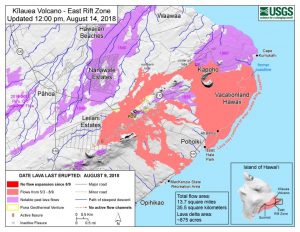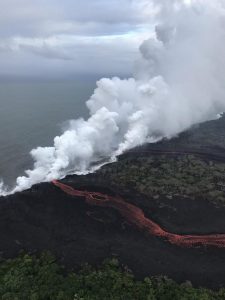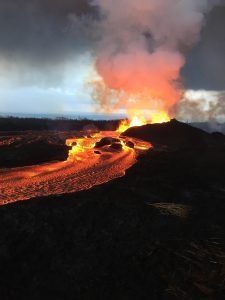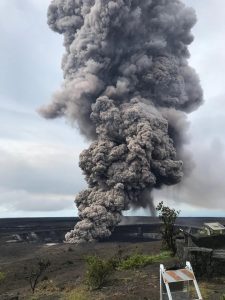Volcanoes
Mauna Loa Eruption (2022)
Mauna Loa is Earth’s largest active volcano and covers just over half of the Island of Hawaiʻi.
This site provides resources about Mauna Loa eruption hazards, vog, and help making a plan.
Also available in: Arabic | English | Español | Français | Haitian Creole | Japanese | Korean | Russian | Tagalog | Vietnamese | Chinese, Simplified
Big Island Volcanic Eruption (2018)
NOTE: This advisory was created and maintained during the 2018 Kilauea volcanic activity on the Big Island. This page has been updated to provide useful information about volcanic activity in Hawaii in general. The 2018 volcanic activity subsided for several years, but Kilauea again became active with an eruption on September 29, 2021, that has brought concerns about air quality due to vog.
ORIGINAL ADVISORY:
Hawaii Volcanoes National Park (HVNP) reopened in late September 2018, following the longest closure in the park’s history, due to volcanic activity. At this time there is no significant volcanic activity happening on the Big Island.
HVNP sustained damage due to seismic activity during the recent eruption, including facilities and roadways. Drive carefully and take precautions when hiking.
HVNP still may have limited services at this time. Visitors are advised to bring snacks, plenty of drinking water, and a full take of gas.
Health Information
Although lava flows have stopped, some fissures continue to release gas. Because of light tradewinds, vulnerable persons may wish to reduce their exposure in the area.
At times of increased volcanic activity, volcanic emissions and volcanic ash are hazardous to health. Vulnerable people in or around the area of volcanic activity are advised to leave when there is such activity. If you stay in the area, limit outside activities and stay indoors if you have breathing issues. Vulnerable people may include the elderly, children, and especially those with compromised respiratory systems such as people with asthma, bronchitis, emphysema, and lung or heart disease.
Recommendations for protecting children in response to volcanic eruptions can be found at the American Academy of Pediatrics website: https://www.aap.org/en-us/advocacy-and-policy/aap-health-initiatives/Children-and-Disasters/Pages/Volcanoes.aspx.
If seismic activity happens during times of elevated volcanic activity, residents in the Volcano area are advised to monitor utility connections of gas, electricity, and water after earthquakes.
Monitor air quality data and forecasts resources provided at the Vog Information Dashboard at www.ivhhn.org/vog.
People affected by volcanic activity, especially those who have been evacuated, may go through a difficult and anxious times. Maintaining mental and emotional health is particularly important. For help with feelings of stress and anxiety, call The Crisis Line of Hawaii 24/7 toll-free at 1-800-753-6879 (or 808-832-3100 on Oahu).
Visitors to Hawaii
Travelers to Hawaii Island can find health-related information at vog.ivhhn.org/advice-visitors-hawaii.
Current Situation

This U.S. Geological Survey (USGS) map, dated August 14, 2018, shows the locations of fissures, including fissure 8, which had been the source of most of the lava flow. Since August 9, 2018, there has been no significant expansion of ʻaʻā flow. At this time there is a reduced level of activity. Where lava enters the ocean, it creates a laze hazard (hydrochloric acid and steam with fine glass particles, sent into the air). The fissure 8 flow has created a lava delta of around 875 acres, filling Kapoho Bay and shallow reefs along the nearby coastline. A light-blue dashed line shows where the former coastline had been. The area outlined in yellow is the Puna Geothermal Venture (PGV). The light-purple areas are lava flows erupted in 1840, 1955, 1960, and 2014-2015. [Click on map to enlarge.]
The volcanic activity has forced evacuations of areas that are at risk of lava flows and toxic gas emissions such as sulfur dioxide (SO2) and other components of so-called “vog” (i.e., “volcanic smog”) that come with them. A series of explosive eruptions at the Kilauea summit have created large plumes of ash and a tremendous amount of ashfall in areas downwind.
The Hawaii Department of Health (DOH) is advising residents and visitors in the vicinity of the Lower East Rift Zone volcanic activity on the Big Island to take precautions and preventive measures to protect their health (see “What can I do?” below).
Threat from volcanic activity. The 2018 volcanic activity has affected eastern portions of the Big Island. More than 700 homes were destroyed by lava and nearly 14 square miles were impacted. For many weeks, most of Hawaii Volcanoes National Park was closed after seismic activity near the park facilities sustained heavy damage due to seismic activity damaged roadways and park facilities. The park reopened September 22, 2018, but with limited services. Visitors should drive carefully and take precautions when hiking. They should also bring with them snacks, plenty of drinking water, and a full tank of gas.

Hazardous “laze” is formed when hot lava hits the ocean, sending hydrochloric acid and steam with fine glass particles into the air, and often carried by the wind. Breathing in laze can cause irritation to the eyes, lungs, and skin. People are asked to stay away from any ocean plume.
Hazardous laze when lava hits the ocean. Because lava may enter the ocean during volcanic activity, there is a hazard from laze (formed when hot lava hits the ocean) sending hydrochloric acid and steam with fine glass particles into the air, often carried by the wind. Health hazards include lung, eye, and skin irritation, and people are asked to stay away from any ocean plume. Due to the laze hazard, everyone is advised to stay away from areas where lava hits the ocean, as the resulting plume travels with the wind and can change direction without warning. The U.S. Coast Guard actively monitors areas where lava enters the ocean, and only permitted tour boats would be allowed in the area.
Danger from volcanic gas. Hawaiian Volcano Observatory advises everyone to be on alert during volcanic activity as volcanic gas travels downwind. Severe conditions may exist in the area that can cause choking and the inability to breathe; people with existing respiratory problems should not be in the area of volcanic activity.
Volcanic ash. Ash emissions from craters within Halemaumau are also a health concern during periods of higher volcanic activity. When explosive eruptions occur, the ash plume from the crater can rise as high as 30,000 feet above the ground, with the resulting ash cloud carried downwind to areas many miles from the volcano. During such activity, communities downwind will likely continue receiving ashfall and should take necessary precautions (see “What can I do?” below). If you are in the path of the ash plume, take shelter. Driving conditions may be dangerous, so if you are driving, pull off the road and wait until visibility improves enough that it is safe to drive.
Stay informed and ready to respond. Residents near volcanic activity are advised to stay informed with the most recent information and latest updates, which can be found at the Hawaii County Civil Defense alerts page. Comprehensive information about the risks of vog, including vog forecasts, can be found at the Hawaii Interagency Vog Information Dashboard.
Impact in Hawaii
Although most of Hawaii Island remains safe, caution should be taken in or around the area of volcanic activity. The volcanic activity and accompanying earthquakes, tsunami risk, and sulfur dioxide (SO2) emissions pose deadly risks. All people in the area must pay attention to official information in order to protect themselves and their family. Always obey official warnings, such as orders to evacuate and tsunami warnings.
Evacuation orders, shelters, and water supplies. Although there had been a mandatory evacuation order for Leilani Estates, from Pomaikai Street and eastward (see map) and other areas, there are currently no evacuation orders. Hawaii County maintains a map of restricted areas and roadways.
When the volcano is active, people in surrounding areas outside the evacuation zone who are vulnerable (e.g., the elderly, young people, and those with compromised respiratory systems such as people with asthma, bronchitis, emphysema, and lung or heart disease) are also advised to leave. All people in the area are reminded that the sulfur dioxide and other components of vog can be extremely hazardous.

Fissure 8 lava fountains. This fountain has reached heights up to 250 feet in past days. The fountain height varies, often sending a shower of lava fragments over the rim of the cone, building it slightly higher and broader. Lava from fissure 8 flows through a well-established channel to the ocean south of Kapoho [Public domain photo from U.S. Geological Survey]
Sulfur dioxide, vog, and volcanic emissions. Volcanic emissions include several chemicals, dust, and sulfur dioxide, which is toxic to the eyes, skin, nose, and lungs. Inhaled sulfur dioxide can react to the moisture of the nose, windpipe, and lungs to form a sulfurous acid (H2SO3), a potent acid and strong respiratory irritant. Children, the elderly, and people with preexisting respiratory conditions such as asthma are particularly vulnerable and should avoid the area. Keep medications on hand and readily available, and contact a healthcare provider if problems develop.
Information on local vog conditions can be found at the Hawaii Interagency Vog Information Dashboard of the International Volcanic Health Hazard Network and at the U.S. Environmental Protection Agency.
The Department of Health is warning consumers that no mask sold in stores provides protection from these gases. Masks known as N-95 or dusk masks are different from those used by emergency responders and do not provide adequate protection. Leaving the area of volcanic activity is the best way to protect yourself and your family. If you live in an community affected by volcanic ash, stay indoors and keep your windows closed.
Earthquakes and tsunami hazards. The 2018 volcanic activity included earthquakes measuring as strong as 6.9 on the Richter scale. If an earthquake strikes, remember to drop, cover, and hold on. All residents and visitors in Hawaii are urged to know what to do before, during, and after an earthquake. Due to frequent earthquakes near the Kilauea summit, residents in the nearby town of Volcano area are advised to monitor utility connections of gas, electricity, and water after earthquakes.
A local tsunami may follow an earthquake. Thus far, none of the earthquakes associated with the volcanic activity have posed a tsunami threat, although there were localized fluctuations in the sea level of up to 16 inches. Tsunami danger is imminent if you feel the ground shaking below your feet, if you see the ocean receding for a long distance, or if you hear a loud roaring sound coming from the ocean waves. Seek higher ground immediately or travel inland for a half-mile.
All residents and visitors in Hawaii are urged to know what to do before, during, and after a tsunami and to heed any tsunami warning sirens by immediately leaving tsunami evacuation zones.
What can I do?
Local residents and visitors are urged to stay informed about when there is ongoing volcanic activity. If they are not already receiving alerts for this and other hazards, they can register to be part of Hawaii County’s emergency notification system by going to this link.
Be aware of vog and vog risk. People on Hawaii Island outside the area of volcanic activity are also advised to monitor levels of vog. When levels of vog are high, avoid outdoor activities that cause heavy breathing, drink plenty of fluids to avoid dehydration, and avoid smoking and second-hand smoke. Stay indoors and close windows and doors. If an air conditioner is in use, set it to recirculate.

Rockfall generates a short-lived explosion at Halema‘uma‘u crater, in Hawaii Volcanoes National Park, May 9. [Public domain photo from U.S. Geological Survey]
Masks for protection from volcanic ash. During times of volcanic activity, N95 masks may be distributed to the general public, depending on availability. Masks do not protect against gases and vapors; they will only provide protection against volcanic ash.
N95 masks are not designed or intended for use by children unless prior pediatric approval has been obtained. N95 masks are generally intended for use by adults, and children and infants may be placed at risk for respiratory problems, breathing challenges, and even suffocation when using these masks. For more information, visit the Food & Drug Administration (FDA) information page on N95 masks.
Water catchment systems and volcanic emissions. Residents on the Big Island who use water catchment systems are advised that volcanic emissions may contaminate these water sources, making them unsuitable for drinking or preparing food. Catchment systems may collect acidic water that can leach harmful contaminants such as lead from roofing and plumbing materials, making the water unsafe for human and animal consumption. Volcanic ash may also interfere with common water treatment methods such as filtration and chlorination, raising health risks. For health and safety reasons, DOH does not recommend using catchment water for drinking or preparing food. County water spigots can be used instead as a safer water supply. A DOH document providing information on maintaining catchment systems in Hawaii can be found at the Department of Health website.
Maintaining mental and emotional health. Many people experience emotional distress from volcanic activity. Evacuations and the insecurity of not knowing what will happen are a source of stress and anxiety for many people, particularly those in or near areas that have been forced to leave their homes.
During times of natural disaster, talk to your family members and friends to maintain a strong support system. Children are particularly vulnerable, as they have trouble processing what is happening. Help your children by sharing age-appropriate information and being honest. Set a good example for children by taking care of yourself. Take breaks and unwind periodically and ask for help if you need it. For help with feelings of stress and anxiety, you can call The Crisis Line of Hawaii 24/7 at 808-832-3100 on Oahu and toll-free at 1-800-753-6879 for neighbor islands.
Learn how to protect yourself from disaster. All Hawaii residents are also advised to learn how to protect themselves from these disasters. Federal, state, and local agencies have information on what you can do before, during, and following a natural disaster:
- Volcanic eruption (Federal Emergency Management Agency)
- Tsunamis (Federal Emergency Management Agency)
- Tsunami evacuation zones (Hawaii Emergency Management Agency)
- Earthquake (Federal Emergency Management Agency)
- Sulfur dioxide and vog (Hawaii Department of Health)
Because of the unpredictability of disasters such as volcanic activity, as well as Hawaii’s isolation, island residents and visitors are vulnerable in case of a major natural disaster. For this reason, people who live in Hawaii are encouraged to have a 14-day emergency supply kit that includes water, food, medication, etc., that will last at least two weeks. For more information, please visit the Department of Health’s disaster prevention pages on emergency kits and on emergency planning.
Resources
Health information for children
- Recommendations for protecting children in response to volcanic eruptions (American Academy of Pediatrics)
Monitor air quality data and forecasts
- Hawaii interagency vog information dashboard (International Volcanic Health Hazard Network)
- Hawaii ambient air quality data (Hawaii Department of Health)
- Hawaii short-term SO2 advisory (Hawaii Department of Health)
- National AirNow website (U.S. Environmental Protection Agency)
- EPA site on Kilauea air quality conditions (U.S. Environmental Protection Agency)
- Vog prediction maps (Vog Measurement & Prediction Project)
Prepare for volcanic hazards
- Volcanic eruption preparation (Federal Emergency Management Agency)
- Volcanic ash impacts and mitigation (U.S. Geological Survey)
- Volcanoes (U.S. Centers for Disease Control & Prevention)
- Volcanic air pollution hazards in Hawaii (U.S. Geological Survey)
Prepare for earthquakes and tsunami threats
- Earthquake preparation (Federal Emergency Management Agency)
- Tsunami preparation (Federal Emergency Management Agency)
- Tsunami evacuation zones (Hawaii Emergency Management Agency)
Information for Clinicians
- Grand Rounds: Health impacts of volcanic emergencies (Pediatric Health Environmental Specialty Units)
- Promoting adjustment and helping children cope in a disaster (American Academy of Pediatrics)
- Environmental Management of Pediatric Asthma: Guidelines for Healthcare Providers (National Environmental Education Foundation)
